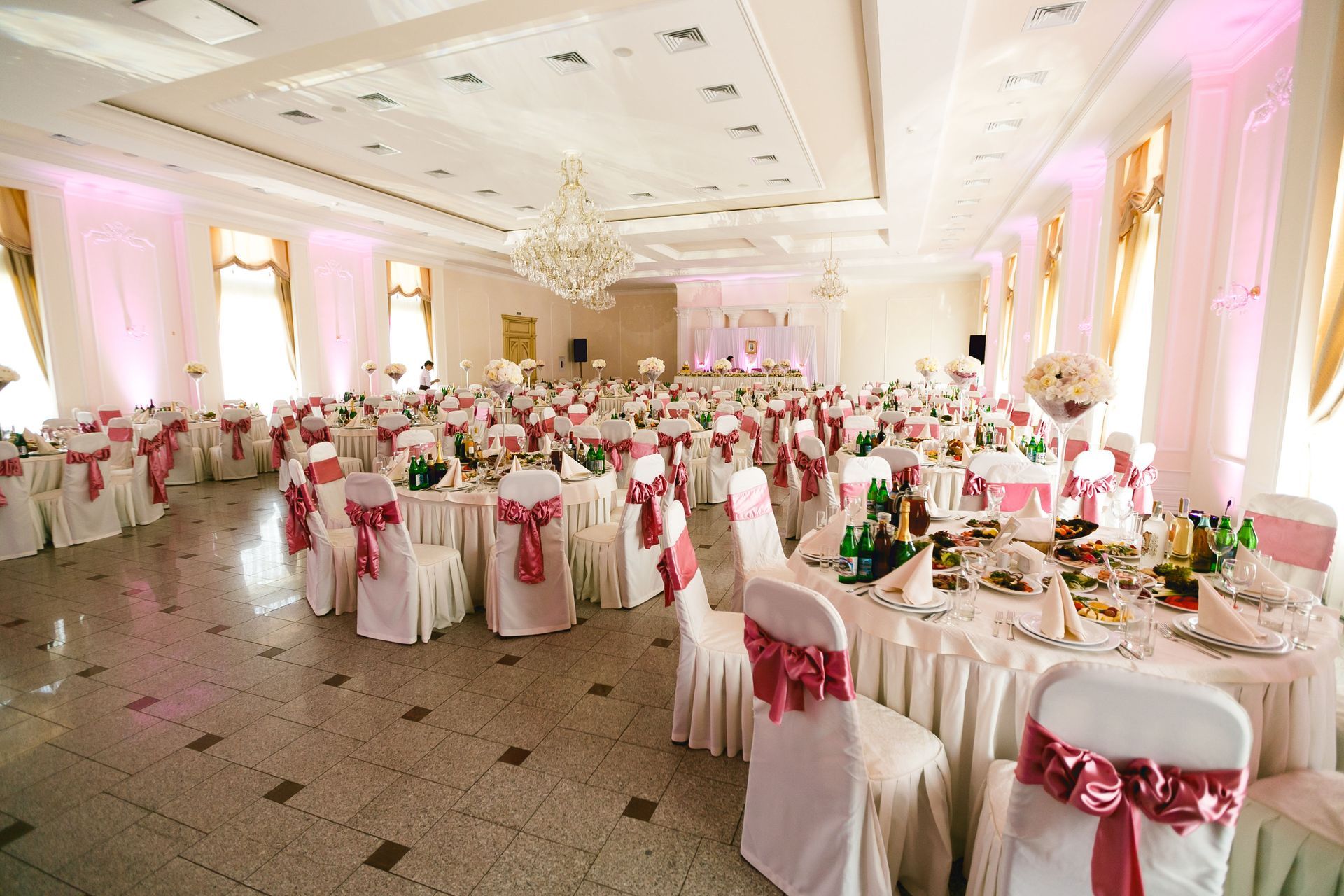November 14, 2025
Understanding the average guest count for U.S. weddings offers valuable insight into evolving cultural, economic, and social dynamics. Weddings mirror societal values and priorities, from financial conditions to lifestyle shifts. As couples increasingly emphasize personalization and meaningful experiences over grand displays, guest list sizes have become an important reflection of how Americans define celebration. According to The Knot, the national average guest count is around 117, though trends vary widely by region, culture, and budget. A professional wedding planner often helps couples find balance between their vision, venue capacity, and budget while keeping the event intimate and memorable.
1. Historical Trends in Wedding Guest Counts
1.1. The Evolution of Wedding Sizes Over the Decades
Wedding celebrations have transformed dramatically over the past century. In the early 1900s, weddings were intimate events, often hosted at home with immediate family. The post–World War II era brought prosperity, leading to larger gatherings and a focus on elegance. During the 1980s and 1990s, lavish receptions became symbols of status, with hundreds of guests common. In recent decades, however, many couples have turned toward smaller, more personalized events that emphasize connection and experience rather than scale. A seasoned wedding planner can help tailor these experiences, ensuring the event aligns with both tradition and modern expectations.
1.2. Influential Events Impacting Guest Numbers
Historical and economic events have played a pivotal role in shaping wedding sizes. The Great Depression and the 2008 financial crisis prompted couples to downsize. Conversely, periods of prosperity—such as the postwar boom and the late 1990s tech expansion—saw surges in larger, extravagant weddings. Global events like the COVID-19 pandemic also transformed how people gather, giving rise to “micro-weddings” and hybrid celebrations that combine in-person and virtual guests. During uncertain times, a knowledgeable wedding planner often becomes essential in helping couples adjust their guest list and event logistics smoothly.
1.3. The Role of Cultural Shifts in Guest Lists
Changing cultural values have redefined what weddings represent. The rise of individualism has encouraged couples to focus on their own preferences rather than societal expectations, often reducing guest counts. Modern couples prioritize authenticity and meaningful interaction, valuing the presence of close friends and family over extensive social networks. As traditions evolve, weddings increasingly reflect the couple’s identity rather than community pressure. A wedding planner can guide couples in translating these evolving values into guest experiences that feel intentional and personal.
2. Regional Differences in U.S. Wedding Guest Counts
2.1. East Coast and West Coast Contrasts
Regional culture heavily influences wedding size. On the East Coast, long-standing traditions and family-centered values often lead to larger gatherings. Meanwhile, West Coast weddings tend to be more relaxed and varied, with guest counts ranging widely depending on style and budget. California’s outdoor venues, for example, attract smaller, more scenic events, while historic East Coast estates often host expansive celebrations steeped in formality. A wedding planner familiar with local customs and vendors can help couples adapt their plans to reflect these regional nuances.
2.2. Midwest and Southern Traditions
The Midwest typically favors gatherings that balance tradition and practicality. Weddings there often include extended family, friends, and community members, resulting in mid- to large-sized events. In the South, weddings are known for their warmth and hospitality, with generous guest lists that can easily exceed regional averages. Southern culture places great importance on community celebration, often making weddings grand social occasions. A wedding planner can help maintain this sense of inclusivity while keeping the event organized and stress-free.
2.3. Urban vs. Rural Weddings
Geography also shapes guest counts. Urban weddings frequently lean smaller, constrained by venue size and high costs. Rural settings, by contrast, allow for larger gatherings thanks to open spaces and lower overhead expenses. City weddings may prioritize exclusivity and intimacy, while countryside weddings reflect a community-oriented spirit where nearly everyone is invited. Wedding planners often help bridge these environmental contrasts by managing logistics suited to each setting.
3. Economic Factors Influencing Wedding Guest Numbers
3.1. Budget Constraints and Financial Priorities
For many couples, financial considerations are the deciding factor in determining guest count. Rising living costs, student debt, and homeownership expenses have led to tighter wedding budgets. Couples are now more selective, inviting only those closest to them. This approach allows for higher-quality experiences—such as premium food, décor, or entertainment—without exceeding financial limits. A skilled wedding planner can provide budget strategies to help couples maximize impact without compromising their goals.
3.2. The Cost Per Guest
Every additional attendee adds to the total cost of catering, venue space, and entertainment. The average cost per guest often ranges, prompting couples to weigh the value of inviting more people versus offering an elevated experience for fewer guests. Many choose to focus their resources on a smaller group, favoring comfort and connection over size. Wedding planners are instrumental in helping couples allocate spending wisely while ensuring the event feels full and festive.
3.3. Industry Pricing and Inflation
With the wedding industry’s steady price increases, managing a large guest list has become more challenging. Vendors often charge per-person rates, influencing couples to limit invitations. As inflation and supply costs rise, even modest weddings can become expensive. The result is a steady trend toward smaller, more intentional guest counts that align with personal budgets and financial security. A professional wedding planner can negotiate vendor pricing and identify creative solutions to stay within budget.
3.4. Economic Downturns and Creative Solutions
Economic downturns often inspire creativity. Couples seeking affordability have embraced solutions such as backyard weddings, weekday ceremonies, and brunch receptions. Others are using virtual technology to include distant friends and family without expanding the in-person headcount. These adaptations highlight the flexibility and resilience of modern couples in balancing celebration with fiscal responsibility. Many turn to their wedding planner to coordinate cost-effective strategies that still deliver memorable experiences.
4. The Impact of Technology on Guest Lists
4.1. Virtual Weddings and Hybrid Attendance
Technology has transformed how people experience weddings. Virtual attendance became mainstream during the pandemic, allowing couples to share their day with guests who couldn’t attend in person. Hybrid formats continue to thrive, giving couples flexibility to keep in-person gatherings smaller while still connecting with distant loved ones. A wedding planner often manages the logistics of these events, ensuring technology runs smoothly while maintaining emotional connection for all guests.
4.2. Digital Invitations and Guest Management
Digital invitations and RSVP systems have simplified planning. Couples can now track responses, manage seating, and communicate updates instantly. These tools not only save time and money but also allow for environmentally conscious choices by reducing paper waste. Online platforms make guest management more efficient, freeing couples to focus on the celebration itself. A tech-savvy wedding planner can integrate these tools seamlessly into the overall event strategy.
4.3. Social Media’s Dual Influence
Social media simultaneously expands and limits guest lists. On one hand, it enables couples to share moments with a broader audience. On the other, it fosters pressure for exclusivity, as some couples prefer to maintain privacy. Many choose to stream highlights online while keeping their physical gatherings small and personal. An experienced wedding planner can help set social media boundaries and coordinate digital sharing policies that align with the couple’s comfort level.
4.4. Technology and Future Planning Trends
Emerging technologies such as augmented and virtual reality are poised to redefine how guests experience weddings. Virtual environments could soon allow friends across the world to “attend” immersive ceremonies without travel. As innovation continues, technology will remain central to expanding access while maintaining manageable guest counts, merging tradition with modern convenience. Wedding planners will continue to play a crucial role in blending these innovations into seamless, meaningful celebrations.
The average U.S. wedding guest count has evolved alongside social values, technology, and economics. From historic ballroom gatherings to contemporary micro-weddings, each generation redefines what it means to celebrate love. Whether couples choose an exclusive dinner for 25 or a grand affair for 250, today’s weddings reflect intentional choices that prioritize authenticity, sustainability, and connection. As trends continue to shift, one truth remains constant—weddings will always serve as a reflection of the times, guided by thoughtful planning and the creativity of a wedding planner. Call Annie Rose Events today to learn more.











